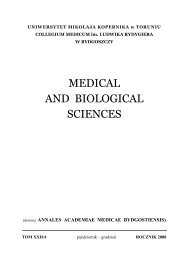Medical and Biological Sciences XXVI/2 - Collegium Medicum ...
Medical and Biological Sciences XXVI/2 - Collegium Medicum ...
Medical and Biological Sciences XXVI/2 - Collegium Medicum ...
Create successful ePaper yourself
Turn your PDF publications into a flip-book with our unique Google optimized e-Paper software.
The assessment of influence of thermoplastic foot pads on the body stability in patients with foot dysfunctions... 45<br />
of 0.41. A significant difference was noted in the<br />
evaluation parameter of the total surface deflections,<br />
which has improved in all groups. Average<br />
improvement of this parameter for both limbs was<br />
similar in the group 5-10 years (9.03) <strong>and</strong> 11-21 years<br />
(8.29), while the results improvement in respondents<br />
aged 22-65 years was smaller by about half (4.73). The<br />
response time for both legs has improved, in relation to<br />
the result obtained before using a thermoform insole;<br />
only in the group 11-21 years, while in the other<br />
groups, it has deteriorated. It should be noted that the<br />
study was conducted on the first day of receiving the<br />
insole, which creates new proprioceptive conditions for<br />
the foot <strong>and</strong> changes the anatomical relations due to the<br />
foot’s correct settings. Such changes could have<br />
affected the deterioration of the response time<br />
parameter.<br />
Analyzing the results of the groups formed on the<br />
basis of determining the height-weight ratios (BMI),<br />
the relationship of weight <strong>and</strong> improved results of the<br />
tested parameters is visible. The final evaluation has<br />
improved the most in patients with underweight, while<br />
the lowest value of the improvement was achieved by<br />
overweight <strong>and</strong> obese patients. The same trend was<br />
observed in the evaluation of improvement of the total<br />
surface deflections parameter for both limbs <strong>and</strong><br />
reaction time parameter. On the basis of the research<br />
results, it appears that the size of the patient’s foot does<br />
not significantly affect the results improvement of the<br />
researched parameters. The results of the final<br />
evaluation ranged between the lowest values of<br />
improvement of 0.72 for the group with insole "S" <strong>and</strong><br />
the higher of 1.3 for the group with insole "XS". It can<br />
be assumed that the differences between the groups<br />
were not significant. The improvement of the total<br />
surface deflection parameter improved significantly in<br />
the groups with insoles size "Kids", "XS", "L",<br />
reaching values in the range of 7.49-8.25. Only a group<br />
of patients with insole "S" has reached the lower<br />
average result of 4.83. The average response time in<br />
groups with insoles size Kids, XS, S, has minimally<br />
improved by the value of 0.06 - 0.07 s. In the group,<br />
which used insole size L, the overall value of the<br />
response time for both legs worsened by the value of -<br />
2.98. St<strong>and</strong>ing on one leg test showed that in 14 cases,<br />
patients who do not have the skills to st<strong>and</strong> on one leg<br />
(left or right) in their own shoes, after using the insole<br />
could maintain balance within a given time. This<br />
means that in 63% of cases insoles positively<br />
influenced the improvement of the ability to maintain<br />
balance in st<strong>and</strong>ing on one leg.<br />
DISCUSSION<br />
Non-physiological conditions accompanying the<br />
growth as well as feet functional failure resulting from<br />
a sedentary lifestyle show that currently, an increasing<br />
proportion of the population requires a treatment of<br />
disorders of abnormally shaped foot. The universality<br />
of this problem causes the growing interest in Podiatry<br />
- a science dealing with the subject of physiology,<br />
pathology <strong>and</strong> feet therapy [14]. There is a more often<br />
necessity to use orthopedic equipment, which is aimed<br />
at correction of developing feet deformities <strong>and</strong><br />
protection of the musculo-ligamentous apparatus from<br />
overloads, arising due to change of normal muscle<br />
activity changes in the way of compensation appears<br />
more often [3]. When considering the influence of<br />
disturbances in the foot area on maintaining a stable<br />
posture, it can be assumed that feet dysfunctions<br />
contribute to the deterioration of the body statics,<br />
which significantly limits the ability to maintain<br />
balance. In addition, the stability of the body depends<br />
on variable factors, hence the research included the<br />
division of the patients based on age, height-weight<br />
ratios <strong>and</strong> the foot size. Analysis of issues related to<br />
assessment of the influence of thermoform insoles on<br />
the body stability improvement in patients with foot<br />
dysfunctions is a new issue, which results from the fact<br />
that the available literature lacks in research of similar<br />
nature. The above research used thermoform insoles,<br />
which are different from ‘st<strong>and</strong>ard’ insoles available in<br />
stores. Increasingly, insoles are treated as a serial<br />
industrial product, which, in our opinion, is an<br />
erroneous assumption. Insoles should be performed<br />
according to individual needs, hence the main aim of<br />
thermoform insoles is the ability to make them on each<br />
foot of the patient, adjusting an insole individually to<br />
the needs of disorders in both right <strong>and</strong> left foot. The<br />
use of thermoform insoles individually tailored to the<br />
disorders aims at functional improvement of feet<br />
efficiency, the correction of feet settings in the shoe<br />
<strong>and</strong> the reduction of pain [9]. The possibility to select<br />
insoles on each foot of a patient individually helps the<br />
right correction of the foot anatomical structures <strong>and</strong><br />
restoring normal activity of muscles stabilizing the<br />
ankle joint, which has a significant impact on control<br />
of body stability.

















